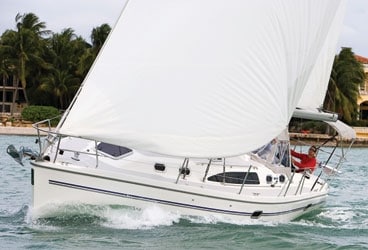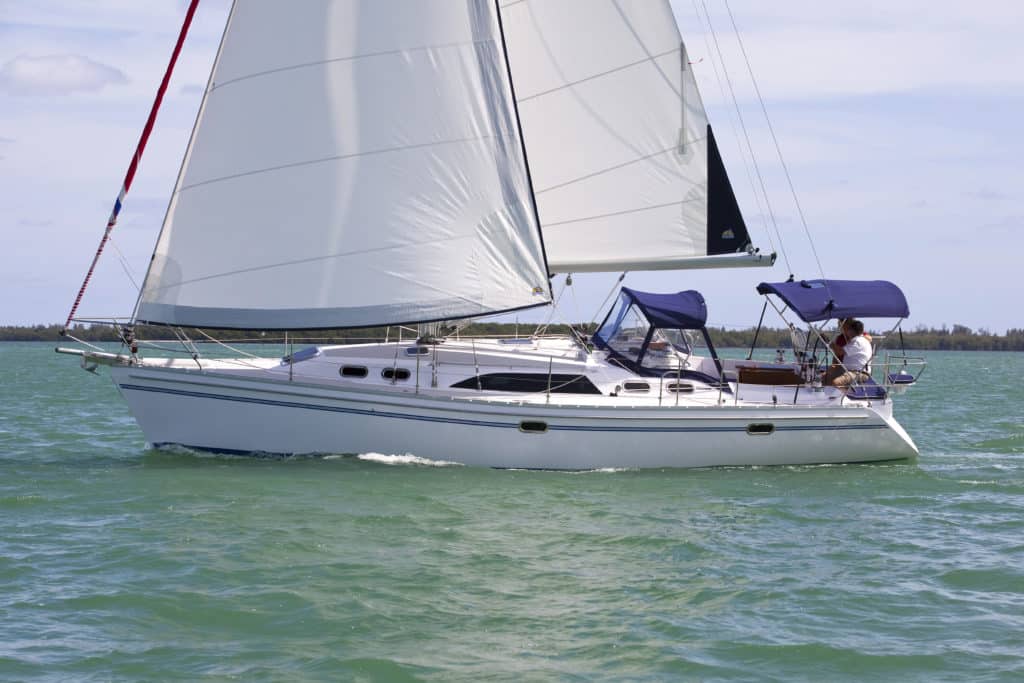
There’s something to be said for having the designer and builder aboard when you’re putting a new boat through its paces. When the wind gusted well into the high teens on Biscayne Bay, south of Miami, last February and the wheel of the new Catalina 375 demanded the driver’s full attention, Gerry Douglas popped his head up the companionway and pointed out that he intended for the first reef to be put in at about 15 knots true. This was easily done with a pull of the in-mast furler’s control line, and it produced dramatic results: The boat stood nearly upright, we immediately gained speed, and all but the slightest pressure on the helm disappeared.
Owners will frequently find themselves in light airs, Douglas says, so he put a larger, more aggressive sail plan on the boat to keep it moving. Besides, with the standard Seldén in-mast furling rig, the main, with its vertical partial battens, can be easily rolled in to meet the conditions, as can the 140-percent genoa, which is set on a Schaefer roller furler.
In winds closer to 10 knots, the 375 sailed closehauled in the mid-5-knot range and gained a knot when cracked off to a reach. The boat drove easily through chop and wakes, thanks to ample buoyancy in its forward sections.
Headsail sheets lead to a pair of Harken 44 winches mounted near the helm; halyards and the mainsheet are trimmed at winches on either side of the cabin top. With a finger still on the wheel, I could just reach the electric winch’s control button to trim the main or to free its sheet from the self-tailer.
With the 375 tied stern to the dock, you board via a swim platform and open transom. There’s lots of storage for gear in the cockpit lockers, including an aft locker deep enough for an outboard. For the Strictly Sail Miami boat show, a folding Lewmar wheel was mounted on the binnacle, but it was replaced by a traditional one for our sail. If it were my boat, I’d go with an even wider-diameter wheel so I could sit farther outboard for better visibility, although it would mean climbing on the seats to move forward.
The 375 comes with 27-inch-high double lifelines for safety and solid handrails on the coach roof. Standing rigging is inboard, so there’s a clear path forward. A split anchor locker is designed to hold two rodes, and a Maxwell 1000 windlass should make lowering and retrieving the hook a simple operation.
The boat’s hull is solid glass; the side decks and cabin top are balsa cored. Deck hardware mounts on glassed-in aluminum backing plates. Garhauer supplies the traveler and also the blocks, which are stainless steel. A structural grid system gets glassed into the hull before a liner and furniture are installed, and there’s no wood in any of the boat’s structural components. The 375 can be fitted with either a fin or a winged keel.

Below, the two-cabin layout offers plenty of space and comfort. Interior woodwork and joinery is natural-colored teak, and the cabin sole is low-maintenance Lonseal that’s glued directly to the hull liner. At the foot of the companionway, a fully stocked galley sits to starboard, and to port, the aft cabin has a queen-sized athwartships berth. Moving forward, there’s an outboard-facing nav desk and electrical panel, then a full-length settee with an ingenious fold-down table mounted on the forward bulkhead. A stainless-steel tube frame opens from beneath the table and can be extended so the top can be opened up to feed a crowd or kept small for an intimate dinner. A fold-up bench for additional dinner seating is stored, when not in use, at the head of the aft berth. A couple might keep the table up, however, and simply eat at the small table and built-in chairs opposite the settee, to starboard.
The forward cabin features an en-suite head, an island queen, and loads of storage. In the Catalina tradition of making everything from keels to sails in-house, the company makes the shower curtain, says Douglas, from .75-ounce spinnaker cloth.
The companionway steps fold up, and a solid-wood engine box can be removed to gain access to the boat’s 40-horsepower Yanmar diesel. Oil and the coolant reservoir are aft, and they’re easy to reach from the aft berth through a pop-off panel.
Under power, I found that the 375 backs responsively. A fixed, three-bladed prop pushed the boat along at a little better than 7 knots at cruising speed (2,800 rpm) and at just over 8 knots wide open (3,000 rpm).
Douglas is a designer who listens to customers and incorporates their ideas when he can. He knows, for instance, that many owners like to work on their boats, so he’s built in water-system drains that are installed at the lowest point in the lines, directly over the deep sump in the bilge, for easy winterization.
“It’s a simple boat, and that was the intent,” says Douglas as he wraps up a tour of the new 375. With that as its design brief, I’d have to say that the new Catalina hits the target square on.
– – –
Mark Pillsbury is Cruising World’s senior editor.








